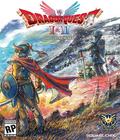In previous Valkyrie Profile, titles, you took on the role of a Valkyrie, a chooser of the slain who takes dead warriors up to Valhalla, sometimes interfering to grant the wishes of a particularly useful spirit in exchange for his or her loyalty. Most of the time, the games don't deal with the situation of those who are left behind and don't get to adventure with the Valkyrie. The original Valkyrie Profile had a few characters who fell into this mold, but they were window dressing for the actual story. Valkyrie Profile: Covenant of the Plume follows the tale of one of the people who were left behind.
Wylfred is the son of a chosen warrior; his father was taken from the battlefield by the Valkyrie. With his father's death, his family fell apart. Since nobody was around to earn money, his sister starved to death, and the loss of both husband and daughter drove his mother to insanity. Naturally, this made Wylfred more than a bit upset, and he dedicated his life to slaying the Valkyrie who destroyed his family. Fortunately (or perhaps unfortunately) for him, his desire for revenge attracted the attention of Hel, Queen of the Underworld, who offered him a deal: He would have one year to use the power of the Destiny Plume to gather great Sin, which would allow him to forge the Angel Slayer and kill the Valkyrie. In exchange, she would get his immortal soul. Wylfred, consumed by revenge and hatred, accepted this rather foolish deal, and the game follows his attempts to seek revenge against Lenneth Valkyrie.
Unlike other Valkyrie Profile titles, Covenant of the Plume is a strategy RPG. Combat takes place on an isometric map, very similar to the kind seen in Final Fantasy Tactics. Players can place up to four characters on the map at a time, and the game plays in a traditional turn-based style. Players and enemies take turns moving their units into position to attack. When not attacking, your players have access to tactics, which are special abilities that cost AP to use. A tactic can be anything from granting extra movement spaces to changing positions with an enemy unit, and they're often the key to doing the most possible damage to enemies. Mage characters also have access to spells, which can be cast using AP to do anything from healing characters to damaging multiple enemies from a distance. While all of these abilities are useful, your primary focus is going to be on setting up your team to attack.
Your positioning matters a lot in Covenant of the Plume, as each character can only attack if he's within weapon range of the enemy. Mages and archers, for example, can attack from darn near anywhere, while pugilists have to be right next to the enemy to join in on an attack. Getting all four of your characters to attack an enemy is essential, and they key to victory is positioning your team so that they can all get in on the fight without leaving them vulnerable to enemy attacks. However, the same applies to enemies, so if enemies can attack you while another enemy is within range, they also get to join in on the attack. This may not sound so bad, except that enemies can do some significant damage, and a single foe can probably kill any of your party members in a few attacks.
In addition to attack positioning, however, you also have to worry about sieges. To conduct a siege, at least two of your characters must be in a grid square somewhere on a straight line to an enemy and within attack range. For a two-person siege, characters must be on opposite sides of the enemy, while three- and four-person sieges require the enemy to be surrounded on three or four sides. When you initialize combat with foes while your team is in siege position, you'll receive a special bonus in combat, ranging from additional items to increased attack strength or extra attacks. The absolute best way to defeat a foe is with a four-person siege attack, but it requires a bit of effort to set up and can leave your team vulnerable to enemy attacks.
Once you attack an enemy, the game changes to a more traditional Valkyrie Profile battle system. You and any allies who are within range will attack the enemy. Each character has a specific number of attacks and is bound to one of the DS' face buttons, so pressing that button makes the character attack. Your goal is to time your button presses to combo the enemy as much as possible before he hits the ground. Repeated combos have a number of benefits: Hitting an enemy in the air can knock out crystals and purple gems, crystals give you extra experience points at the end of battle, and purple gems grant an extra attack. Learning which attacks can best knock out purple gems is essential to doing the most possible damage with a single attack, since each additional orb can significantly increase the damage you inflict.
In addition to purple gems and crystals, beating enemies with lengthy combos also fills up your Soul Crush meter. When it's full, you can activate a Soul Crush, a super-powerful attack that can be used by any character equipped with a weapon that's capable of Soul Crushes. These special attacks do phenomenal damage, and each character in your team can perform one Soul Crush per fight. They even refill the meter and allow you to chain them together to do a ridiculous amount of damage, although chaining together more than three Soul Crushes requires some forethought. Different characters have different Soul Crushes; some are better are refilling the meters, while others inflict a ton of damage but have a tough time maintaining a Soul Crush chain. This should all feel very familiar to anyone who played Valkyrie Profile or Valkyrie Profile: Silmeria, as this system is almost identical to the combat in those titles.
Attacking an enemy isn't without risks. If an enemy survives your attack and is within range, he'll have the option to launch a counterattack on one of your units. With regular enemies, this can be nasty, but it can be potentially disastrous with boss characters, as a single boss can kill multiple teammates if you're particularly unlucky. There are a few ways to get around this. Attacking from outside an enemy's attack distance prevents him from counterattacking, although this is usually only an option for mages and archers. If you perform a particularly long combo or have certain skills equipped, you can make an enemy dizzy. If you run out of attacks when the enemy is in a dizzied state, he can't counterattack, although this only lasts for a short period of time. The most effective way to win a fight is to simply defeat your foe in a single long attack. Even the most durable foes will fall to a few four-person attack chains, assuming you prepare well.
Winning a battle isn't as easy as defeating your enemies because the contract between Wylfred and Hel comes with certain requirements. As a result, Wylfred must "sin" in order to keep Hel satisfied. At the beginning of every plot battle, you'll be given a sin requirement to meet. To do so, you must deal Overkill damage to enemies by doing damage to them after they've already been defeated. For every 1 percent of their total health that you do in Overkill damage, you'll receive 1 sin point, up to 100 per foe. The optimal way to kill a baddie isn't just to eke out a victory, but to deal enough damage with a single attack that you kill him twice over. A great deal of your strategy in fights will not just be figuring out how to defeat an enemy, but also how to do so while dealing Overkill damage and without leaving your squishy warriors in vulnerable positions. A full four-person attack on any non-boss foe will give you 100 sin points, and even bosses can be Overkilled without too much effort, as long as all four of your party members are doing their part.
Sin has its risks and rewards in Covenant of the Plume. If you meet the sin requirement for the stage, Hel will be pleased and gift you with items, and you'll receive better items if you've racked up more sin points. If you manage to double the sin requirement for the stage, you'll receive rare and powerful equipment, while barely meeting it may yield a token prize. Fail to meet the sin requirement, and you'll encounter Hel's wrath. In addition to receiving no prizes, the next map will feature a Realmstalker, an extremely powerful "bonus" enemy who exists to make your life harder. In case you can't tell, the game strongly encourages you to exceed the sin requirement.
Wylfred has another tool at his disposal, and perhaps it's the most important of all: The Destiny Plume. This plume, the symbol of the covenant between Hel and Wylfred, allows Wylfred to invoke dark powers. At any time, he can choose to use the plume on a trusted ally, which gives the ally a tremendous power boost for the rest of the stage and instantly fills your sin requirement. An ally who has been plumed is unstoppable and can finish the rest of the stage on his or her own. However, this power comes at a cost: Whoever the plume is used on will die at the end of the stage.
In exchange, Wylfred with receive a new tactic, often an incredibly powerful ability that can turn the tide of battle. This power comes at more than just the cost of your ally's life. Using the plume changes the story, and with the exception of the first two chapters in the game, each successive chapter and the overall ending depend on your plume usage. To achieve the best ending the game has to offer, you'll have to go through the game and never rely on the power of the plume. Furthermore, there are a set number of times you can use a plume during chapters 2 to 4. Overuse it, and the Goddess Freya will show up and wipe you out to halt the spread of your dark power. Generally, as long as you only use the plume when it's necessary, this will not be an issue, but players will want to be cautious about overusing it.
This may sound fairly simple, but the deck is stacked against you. Your character is at an unfair disadvantage for most fights in Covenant of the Plume. You may begin in a disadvantageous position, whether it's facing enemies who have a terrain advantage or having to defend someone from attacks while he's on the other side of the map. There is even a rush of stages without save points in between, which makes it harder to simply reset and try again if you screw up. Reasonably talented gamers shouldn't have too much trouble getting through these problems, but the game keeps throwing situations at you that are designed to encourage you to use the plume and take advantage of the overwhelming power.
This is going to be the point where Covenant of the Plume may lose some players. Although the game is fun, it's not always fair. The odds are against you, and while it's possible to win every single stage, it is entirely feasible that you could encounter a situation where you just can't figure out the right tactics. This is what the plume is for, but not every gamer will enjoy having the take advantage of a "get out of trouble" card to beat a stage instead of using their own abilities. If players are keeping up with their sin equipment, there should be little difficulty in keeping the party well-stocked and capable of kicking butt.
The stage design is fairly interesting, although a few of the levels could really use some tweaking. Defense missions are rarely fun, and while I understand the idea behind them, especially when encouraging you to use the plume, it can still be a bit annoying when the idiotic AI decides to attack a strong enemy instead of being sensible and hiding in a corner. Fortunately, once you can reach the AI, keeping them alive is easy. You have to hope that they don't do something completely stupid before you reach them, and the game loves to start you at the opposite side of the map from them. The objectives can also be a bit unclear, and this doesn't pose an issue most of the time, but it can be annoying when you accidentally end a mission by killing an enemy you thought you could safely defeat, or when you spend half a mission guarding a guest character only to discover that he could have died without any repercussions. The majority of the game's missions are both fun and challenging, although experienced gamers will certainly want to shoot for the best ending on their first playthrough to ensure the best experience possible.
It's worth noting that there is no real way to "grind" in the title. Beyond a few optional missions, which have no sin requirement and can be played entirely to earn levels, you're on a fairly linear path. The best way to power up your character is with sin or plume usage. This is a bit of a mixed bag, since it means that a player who simply can't win a stage has little way to boost his character's power. On the other hand, levels are less useful than sin equipment, and the plume is always available if you absolutely need it. It's almost impossible to get stuck in a situation where you have no way of winning, because even if you overuse the plume to the point where another use would end your game, it'll mean that Wylfred has a tremendous collection of powerful tactics at his disposal.
At first glance, Covenant of the Plume is a fairly short game. Getting to the ending will probably take you about 10 hours, but the game isn't designed to be played through only once. With the exception of the very first chapter, every chapter has three possible variations you can encounter, and each tells part of an overarching story. A character who is a villain in one playthrough may have a more heroic side in another, while others may live or die depending entirely on your actions. To see the full story and find out everything about every character, you'll have to play the entire game three times. Fortunately, the title does a lot to make this easy on you. After you reach an ending, you can restart the game with all your equipment and learned tactics, which makes subsequent playthroughs much easier. Players shouldn't be afraid to use the plume because if they absolutely can't win, they can still get an ending and begin a new game with plume-earned tactics and equipment, which makes it easier to get the better endings. All in all, viewing the entirety of Valkyrie Profile's story will take about 20-25 hours.
Finishing the game three times isn't just something that you need to do for the plot. You must view all three of the endings in order to unlock the Seraphic Gate. In previous Valkyrie Profile titles, the Seraphic Gate was a super dungeon that provided a greater challenge to players. The Covenant of the Plume Seraphic Gate begins you at level 1, with default equipment, no items, no tactics and every character in the game. You'll slowly trek through increasingly difficult levels, earning new items, new characters, and amusing cameos and references for your hard work. This is where the gameplay really begins to shine because these levels are designed to take advantage of your basic tactical abilities. There are no sin requirements in these fights, and you can't use the Destiny Plume or any plume abilities to make things easier on yourself. It takes a lot to unlock, but Seraphic Gate adds a lot of replay value.
Covenant of the Plume is very cute for a game about such a depressing and unhappy world. All of the sprites are small but very full of life and detail, especially in battle. The animations are smooth, and despite the small size of the characters, it's very easy to see what's going on. There are also some surprisingly neat animations, especially for certain Soul Crushes and combo attacks. It can take a while to learn to judge combo distances and juggling due to the isometric view, but it works surprisingly well, and most players should be able to pick it up within a few stages.
The soundtrack is great and is mostly comprised of songs from the original Valkyrie Profile with a mix of some new tunes, which were once again composed by Motoi Sakuraba. The title features English voice acting only in the combat scenes, but it is quite good and rarely gets annoying despite the repetition in the battle quotes. You'll probably get a bit sick of hearing the end of a Soul Crush, but other than Wylfred, you'll never stay with any character too long prior to the Seraphic Gate.
Valkyrie Profile: Covenant of the Plume is a great RPG that's held back by a few nagging flaws. The combat system is an interesting blend of strategy and the battle system from Valkyrie Profile, and the combination works much better than expected. The plot is interesting and lengthy, and there is a ton of replay value to be had. However, there are some things that may turn off players from the game. It can be unfair, although intentionally so, and not everyone will enjoy having the odds stacked against them so heavily. The game is also built around the idea of replaying to see multiple story outcomes, and unlocking everything in the game requires a minimum of three playthroughs. Minor complaints aside, Covenant of the Plume is a fun and unique strategy RPG, and it's a solid addition to any DS owner's RPG library.
Score: 8.5/10
More articles about Valkyrie Profile: Covenant of the Plume











 Valkyrie Profile: Covenant of the Plume follows the story of the young soldier Wylfred, who seeks retaliation against the valkyries since Lenneth took his father's life. Now he waits for an opportunity to strike back just as the future of Midgard is about to be decided in battle once again.
Valkyrie Profile: Covenant of the Plume follows the story of the young soldier Wylfred, who seeks retaliation against the valkyries since Lenneth took his father's life. Now he waits for an opportunity to strike back just as the future of Midgard is about to be decided in battle once again.























































